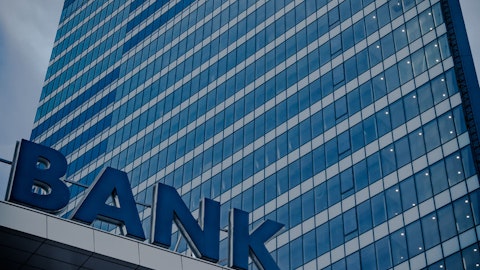KeyCorp (NYSE:KEY) Q3 2023 Earnings Call Transcript October 19, 2023
KeyCorp beats earnings expectations. Reported EPS is $0.29, expectations were $0.27.
Operator: Good morning, and welcome to KeyCorp’s Third Quarter Earnings Conference Call. As a reminder, this conference is being recorded. I would now like to turn the conference over to the Chairman and CEO, Chris Gorman. Please go ahead.
Chris Gorman: Thank you for joining us for KeyCorp’s third quarter 2023 earnings conference call. Joining me on the call today are Clark Khayat, our Chief Financial Officer; and Mark Midkiff, our Chief Risk Officer. On Slide 2, you will find our statement on forward-looking disclosure and certain financial measures, including non-GAAP measures. These statements cover our presentation materials and comments as well as the question-and-answer segment of our call. I am now moving to Slide 3. This morning, we reported earnings of $266 million or $0.29 per share. Our results reflect broad-based growth across our franchise supported by our strong balance sheet and disciplined risk management. We continue to benefit from our focus on relationship banking and primacy, namely having our client’s primary operating account.
We continue to add and deepen relationships in both our consumer and commercial businesses as well as improved both the quality and diversity of our deposits. Average deposits increased relative to the prior quarter and the year-ago period. Our focus on relationship continues to guide our balance sheet optimization efforts. This quarter, we reduced average loans by over $3 billion as we deemphasized credit only and other non-relationship business. Importantly, our common equity Tier 1 ratio increased by 50 basis points to 9.8% as a result of our proactive balance sheet management. Risk weighted assets decreased by $7 billion in the third quarter and $9 billion from the beginning of the year, which is approaching our 2023 full year target of $10 billion.
The increase in our common equity Tier 1 ratio this quarter moves us above our current targeted capital range of 9% to 9.5% where we would expect to remain for the foreseeable future. Other capital ratios were relatively stable this quarter, including our tangible common equity ratio, which was down 10 basis points, despite the impact of higher interest rates. Overall, our capital remains strong and we are well positioned relative to our capital priorities and of the phase-in of the proposed future capital requirements. Although we would not expect the same magnitude of change in risk weighted assets next year, we will continue to take steps to manage our balance sheet in conjunction with anticipated regulatory changes. Net interest income in the quarter reflected the continued high interest rate environment and our balance sheet positioning.
Clark will discuss our balance sheet in his remarks, but I would point out that Key is a very well defined net interest income opportunity over the next five quarters as our short-term swaps and treasuries reprice. In our slide deck, we show net interest income benefit will reach approximately $1 billion on an annualized basis by the first quarter of 2025. Our net interest margin has been a challenge for us this year. We believe, however, the third quarter represented the low point for the cycle. Our results continue to benefit from our strong fee-based businesses, which consistently make up 40% of our revenue. This revenue mix will be a clear competitive advantage under the proposed regulatory framework. This quarter, fee income was up 6% driven by a 17% linked quarter increase in investment banking and debt placement fees.
We expect investment banking fees to increase again in the fourth quarter based on current pipelines. The absolute level of improvement is of course market dependent. Given the significance of our integrated corporate and investment bank, any normalization in the capital markets represents an upside opportunity for Key from both a fee generation and balance sheet management perspective. In addition to capital markets, our fee income will continue to benefit from our strong positions in both payments, an area where we have consistently invested, and as well where we benefit from critical mass with assets under management of $53 billion. Expense management remains a priority. Our results reflect the successful completion earlier this year of a company-wide effort to improve productivity and efficiency.
We are continuing our efficiency journey by further simplifying and streamlining our businesses. As we narrow our focus, we will continue to drive additional expense savings, which provide the funding to continue to invest in our business. Finally, I want to comment on credit quality, which I believe is the most important determinant of return on tangible common equity and shareholder value over time. Credit quality remains a clear strength of Key. Our credit measures reflect the derisking we have done over the past decade and our distinctive underwrite distribute model. This quarter, our net charge-offs were 24 basis points. Over the next several quarters, we expect to continue to operate below our targeted through the cycle range of 40 to 60 basis points.
The quality of our loan portfolio continues to serve us well with over half of our C&I loans rated as investment grade or the equivalent. Similarly, our consumer clients have a weighted average FICO score of approximately 770 at origination. As a reminder, we have limited exposure to leverage lending, office loans and other high risk categories. B and C class office exposure in Central Business Districts totaled $116 million. Two-thirds of our commercial real estate exposure is in multifamily, including affordable housing, which continues to be a significant unmet need in this country. I will close by underscoring my confidence in the long-term outlook for Key. Our businesses are well positioned and we continue to strengthen our balance sheet.
Credit quality remains one of our most significant strengths. We will continue to focus on maintaining the quality of our loan book and enhancing our risk management framework. This positions us well to deliver sound profitable growth and create value for our shareholders. With that, I’ll turn it over to Clark to provide more details on our results for the quarter. Clark?
Clark Khayat: Thanks, Chris. I’m now on Slide 5. The third quarter net income from continuing operations was $0.29 per common share, up $0.02 from the prior quarter and down $0.26 from last year. Our results were generally consistent with the guidance we provided for the quarter and we’ve affirmed the full year outlook we shared at our last earnings call. As Chris highlighted in his remarks, our results reflect the strength of our core business, focus on primacy, balance sheet optimization and our disciplined risk management. I’ll cover each of these strategic focus areas in my remarks this morning. Turning to Slide 6. Average loans for the quarter were $117.6 billion, up 3% from the year-ago period and down 3% from the prior quarter.
Total loans ended the period at $115.5 billion, down $3.5 billion from the prior quarter. The decline in average loans was driven primarily by a reduction in C&I balances, which were down almost 4% from the prior quarter. The reduction reflects our balance sheet optimization which prioritizes full relationships and deemphasizes credit-only and non-relationship business as we prepare the balance sheet for a Basel III endgame rules. The reduction in loans contributed to the decline in risk weighted assets representing roughly half of the RWA decline this quarter. RWAs were also impacted by our optimization efforts to which we were able to apply more attractive capital treatment to existing portfolios. Importantly, this allowed us to manage RWAs proactively while minimizing impacts in net interest income.
Turning to Slide 7. Key’s longstanding commitment to primacy continues to support a stable, diverse base of core deposits for funding. This quarter, average deposits totaled $144.8 billion, relatively stable from the year-ago period and up nearly $2 billion from the prior quarter. The increase in average deposit balances from the prior quarter was driven by an increase in both consumer and commercial deposit balances. Importantly, we’ve continued to improve the quality of our funding mix by growing core relationship balances and reducing wholesale and broker deposits. This quarter, broker deposits declined by $2.6 billion on average and $3.2 billion relative to period end balances. At the end of the quarter, we took advantage of our improved funding profile and called $1.2 billion of outstanding bank debt for redemption.

A friendly representative helping a customer with setting up a bank account.
We expect to redeem the debt at the end of October. Our total cost of deposits was 188 basis points in the third quarter and our cumulative deposit beta, which includes all interest bearing deposits, was 46% since the Fed began raising interest rates in March 2022. Higher interest rates resulted in the continued deposit mix shift this quarter. We’ve seen this mix shift slow and we are testing reduced rates in certain markets. We did not deploy higher rates in our retail business against the July interest rate hike. We continue to expect that our cumulative deposit beta will approach 50% by the end of the year. Turning to Slide 8. Taxable net interest income was $923 million for the third quarter, down 23% from the year-ago period and down 6% from the prior quarter.
Our net interest margin was 2.01% in the third quarter compared to 2.74% for the same period last year and 2.12% for the prior quarter. Year-over-year, net interest income and the net interest margin were impacted by higher interest bearing deposit costs and a shift in funding mix to higher cost deposits and borrowings. Relative to the second quarter, the decline in net interest income reflects a planned reduction in earning asset balances from our balance sheet optimization efforts and higher interest bearing deposit costs. Our net interest margin and net interest income continue to reflect a headwind from our short-dated treasuries and swaps. Our swap portfolio and short-dated treasuries reduced net interest income by $370 million and lowered our net interest margin by 80 basis points this quarter.
We believe that NIM bottomed in the third quarter as we see continued benefit from maturity of swaps and treasuries. Consistent with our previous comments we expect that we are at or near the bottom on NII. In the third quarter, we executed $6.7 billion of spot pay-fixed swaps. In October, subsequent to the quarter end, we terminated $7.5 billion of received fixed cash flow swaps which were scheduled to mature throughout 2024. The swap termination locked in the AOCI position of those swaps, which will amortize throughout 2024 on the original maturity schedule. This should have no impact to our AOCI position at the end of 2024, but will guard against future hikes or reduction in rates that is slower than the forward curve predicts. These actions along with the planned maturity of our short-term treasuries make Key less liability sensitive, protect capital and reduce our exposure to higher rates.
Turning to Slide 9. As Chris mentioned earlier, our balance sheet positioning, which has been a near-term drag on earnings, represents a clear and well defined opportunity. Based on the forward curve which continues to adjust to higher levels, we project an annualized net interest income benefit of approximately $1 billion from the maturities of our short-term treasuries and swaps by the first quarter of 2025. We’ll continue to take a measured but opportunistic approach to lock in this benefit. Moving to Slide 10. Noninterest income was $643 million for the third quarter of 2023, down $40 million from the year ago period and up $34 million from the second quarter. The decrease in noninterest income from the year-ago period reflects a $23 million decline in corporate services income due to lower customer derivatives trading revenue.
Additionally, service charges on deposit accounts declined $23 million driven by the previously announced and implemented changes in our NSF/OD fee structure and lower account analysis fees related to interest rates. The increase in noninterest income from the second quarter reflects a $21 million increase in investment banking and debt placement fees and an $18 million increase in other income from higher trading income and a gain on a loan sale. I’m now on Slide 11. Total net interest expense for the quarter was $1.1 billion, up $4 million from the year-ago period and up $34 million from last quarter. Compared to the year-ago quarter, computer processing expense increased $12 million driven by technology investments and personnel expense increased $8 million driven by higher salaries and employee benefits partially offset by lower incentive and stock-based compensation.
The increase in expenses relative to the prior quarter was driven by personnel expense, which increased $41 million from incentive and stock-based compensation, a majority of which was from production-related expenses and a higher stock price at the end of the quarter. As we continue to proactively manage our expense base and simplify and streamline our businesses, this will improve the client experience, reduce complexity in costs and provide flexibility to continue to invest for the future. Our goal, as expressed previously, is to again keep core expenses flat in 2024. We expect to have additional efficiency-related expenses in the fourth quarter connected with these efforts. With that complete, we would estimate those charges to be in the range of $50 million.
We’ll provide full 2025 guidance during our fourth quarter earnings call. Moving now to Slide 12. Overall, credit quality and our related outlook remain strong. For the third quarter, net charge-offs were $71 million or 24 basis points of average loans. While non-performing loans and criticized loans continue to move up from their historical lows, we believe Key is well positioned in terms of credit migration and potential loss content. Our provision for credit losses was $81 million for the third quarter and our allowance for credit losses period-end loans increased from 1.49% to 1.54%. Turning to Slide 13. We ended the third quarter with a common equity Tier 1 ratio of 9.8%, up 50 basis points from the prior quarter and well above our targeted range of 9% to 9.5%.
Going forward, we expect to stay above our current targeted range. We will determine and share any changes to that targeted range once the new capital rules are finalized. We will remain focused on building capital in advance of newly proposed capital rules and continue to support client activity and the return of capital. We do not expect to engage in material share repurchase in the near term. The right side of this slide shows Key’s expected reduction in our AOCI mark. The AOCI mark is expected to decline by approximately 27% by the end of 2024 and 39% by the end of 2025, which will provide approximately $2.5 billion of capital build through that timeframe. During the third quarter, the AOCI position decreased by $500 million in structural burn down.
The increase in rates, specifically in the five-year timeframe, increased the position by approximately $1.1 billion, which resulted in a net change of $600 million. Importantly, only 10% of our projected $2.5 billion of AOCI reduction between now and 2025 is driven by the benefit of lower rates represented in the current forward curve. Said differently, more than 90% of this reduction will occur even if rates remain flat to current levels driven by maturities, cash flows and timing. Given the proposed capital rules, we believe our reduction in AOCI marks along with our future earnings and balance sheet management would allow us to organically accrete capital to the required levels. Slide 14 provides an outlook for the fourth quarter relative to the third quarter as well as the full year compared to the prior year.
Our guidance uses the forward curve as of September 30, which holds Fed funds flat at 5.5% through August of 2024 ending 2024 at 5%. Balance sheet trends are tracking as anticipated. We expect average loans to be down 1% to 3% in the fourth quarter versus the prior quarter as we continue to optimize our balance sheet and recycled capital to support relationship clients. We expect average deposits to be relatively stable in the fourth quarter. Our outlook assumes a cumulative deposit beta approaching 50 by year end. We also expect to continue to improve our funding mix and liquidity. On a linked quarter basis, net interest income is expected to be relatively stable in the fourth quarter changed from our previous guidance of flat to down 2%. Our guidance for noninterest income has changed to up 1% to 3% reflecting stronger fee income in the third quarter compared to the fourth quarter.
Our full year outlook for fees remains unchanged. Noninterest expense is expected to remain relatively stable in the fourth quarter, excluding the potential FDIC special assessment charge, additional efficiency-related expenses and an expected pension settlement charge of $15 million to $20 million. We expect credit quality to remain solid and net charge-offs to average loans to be in the range of 25 to 35 basis points in the fourth quarter below our expected over the cycle targeted range of 40 to 60 basis points. Guidance for fourth quarter GAAP tax rate is 18% to 90%. Once again, our full year outlook for 2023 versus the prior year has not changed. We feel competent in the foundation of our business and in our strategic efforts to strengthen capital and liquidity, manage risks and improve earnings.
With that, I’ll now turn the call back to the operator for instructions for the Q&A portion of the call. Operator?
See also 30 Least Developed Countries in the World and Funds that Invest in Them and 40 Highest YouTube CPM Countries in 2023.
Q&A Session
Follow Keycorp W (NYSE:KEY)
Follow Keycorp W (NYSE:KEY)
Operator: Thank you. [Operator Instructions]. Our first question will come from Scott Siefers from Piper Sandler. Please go ahead.
Scott Siefers: Good morning, everyone. Thanks for taking the questions. So great news that we kind of hit the low on the margin and are at or near the bottom on NII. I guess I’m curious. Does that outlook contemplate any further risk weighted asset reductions that might be outside the scope of the 10 billion you’ve articulated for this year? And I guess along those lines, do you see a need to do anything beyond what you’ll do this year? It looks like you’re kind of ramping up the capital base more quickly. So how are we thinking about overall balance sheet size within the scheme of bottoming a NII trajectory?
Chris Gorman: Yes. Thanks, Scott. Our prompt bet was that your first question would be expenses, but [indiscernible]. The way I would think about it is we’ve guided the loan balances down 1 to 3 in the fourth quarter. I think that’s going to be the vast majority of any reduction in the balance sheet. We could still see cash come down a bit. And we are still doing some optimization efforts. They won’t carry the same size that we would have seen in this quarter. So you’ll see a leveling off of that. And that 10 billion I think is the right number to be focused on.
Scott Siefers: Okay. Perfect. That’s good. Thank you. I did have an expense question. I think you largely hit it in there. So I’ll refrain from asking about that one. I guess maybe a broader question though. Clark, I think you talked about a 3% margin in a normal environment. I think that’s still well above what would be implied by the extra 1 billion or so of benefit through next year. So maybe just sort of top level, what else would have to happen to get you there? How are we sort of thinking about that, that 3% normalized margin?
Clark Khayat: Yes. So to be clear, I think 3-ish area is, again, not out of the realm. I think to your point, Scott, you adjusted today the 80 basis points that we talked about on drag. It’d be a 2.81. Would have been 2.85 last quarter, kind of 3.19 before that. So I think it’s going to be kind of continued asset mix over time and funding mix. And what you’re seeing, if I just point to the third quarter, you saw kind of flattish deposits and that included a significant reduction in brokered, so more client deposits. But the other piece that I think is really important is that we did and we will continue to focus on reducing our reliance on wholesale funding. So you would have seen that come down on the order of like 4 billion in the quarter, and obviously that has more expense over time.
Now your next question is probably once we get into long-term debt rules and we’re issuing more wholesale debt, how does that impact that? I think we size that a little bit. We will factor that in. But again, I think when you start to put all these pieces together in a more normalized environment, something in the high 2s to 3s is not out of the realm of possibility.
Scott Siefers: Okay. Perfect. All right. Thank you guys very much.
Operator: Thank you. The next question is from Erika Najarian from UBS. Please go ahead.
Erika Najarian: Hi. Good morning. I guess my question was on the RWA mitigation. So I’m going to follow up in terms of Clark’s answer to that question. So you’re pointing us to the 10 billion as the right area, which is a lot, it’s a lot of RWA to take out. And I guess I’m wondering, number one, could you give us a sense of how much has already been taken out and what’s to come? And second, as we think about the net interest income trajectory for next year, there’s a comment of the NII bottoming about here or in the fourth quarter, consider the cost of the RWA mitigation that you have left?





